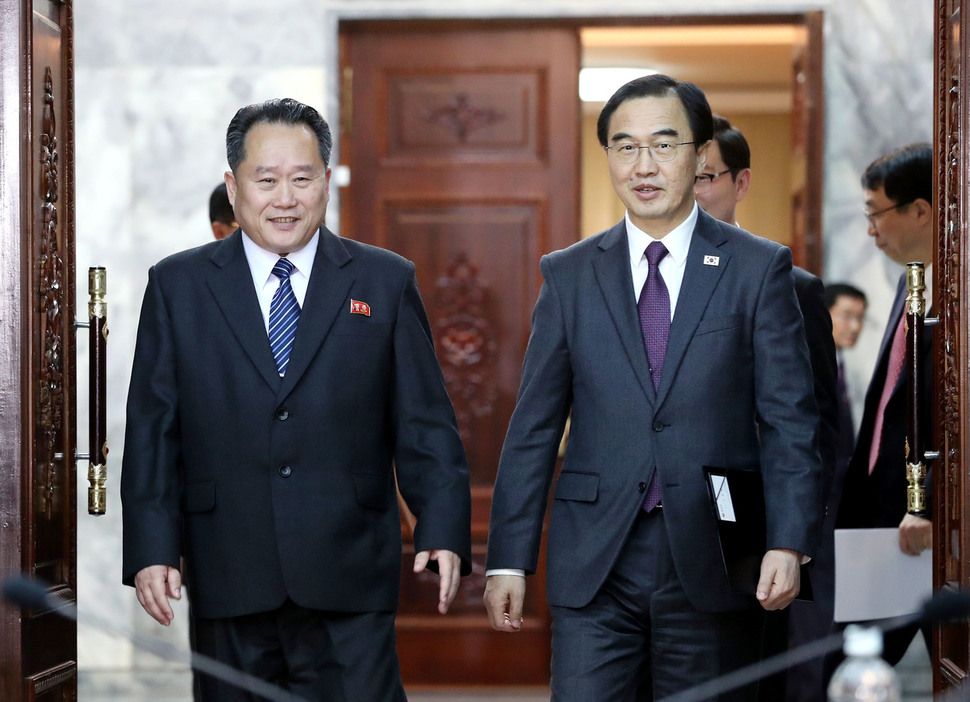 |
|
South Korean Unification Minister Cho Myoung-gyon and North Korean Committee for the Peaceful Reunification of the Fatherland (CPRF) chairman Ri Son-kwon walk together toward the meeting room at the Tongilgak building in Panmunjeom to being high-level talks on Mar. 29. (Photo Pool)
|
High-level representatives of the two sides skipped lunch and quickly concluded work on the joint statement
In their second round of high-level talks in 79 days, South and North Korea agreed to hold an inter-Korean summit at the Peace House on the South Korean side of the Panmunjeom Joint Security Area on Apr. 27. The situation is progressing at a rate that would have seemed unimaginable as recently as the first round of talks on Jan. 9. Once the South and North Korean leaders hold negotiations, the stage will be set for a first-ever North Korea-US summit in May. The focus of war fears just a year ago, the Korean Peninsula has been making rapid strides toward an end to the Cold War regime since the Pyeongchang Winter Olympics. “It has been less than three months since January 9,” said Unification Minister Cho Myoung-gyon on Mar 29, while serving as senior South Korean representative to the high-level talks at the Tongilgak Building on the North Korean side of Panmunjeom. “If you look at the various things that have transpired between South and North during this time, it’s been more than half the battle by just getting started – we’ve had a lot of good outcomes,” Cho said. Committee for the Peaceful Reunification of the Fatherland (CPRF) chairman Ri Son-kwon, North Korea’s representative, also noted that “many theoretical things that had never existed before in inter-Korean relations have taken place in the last 80 days.” “As the Korean proverb holds, I feel the sort of records that may long be remembered in the history of the Korean people, including the Pyeongchang Olympics, have been rightly achieved because we put our hearts together, we coordinated our wills, and we combined our power and efforts,” Ri continued. Representatives of the two sides skipped lunch that day as they made rapid progress on a three-point joint press statement including a schedule for the summit. While the statement did not mention specifics about the summit’s agenda, the smooth progress in the talks suggests the two sides had no major disagreements. “There was some exchanging of views on the summit agenda,” Cho said at a briefing after the meeting. “The North’s positions were not too different from ours,” he added. The South Korean government previously named three agenda items for the summit: denuclearization of the Korean Peninsula, establishment of peace, and advancement of inter-Korean relations. The three areas are closely interlinked. For North Korea to go the denuclearization route, the military threat against it would have to be resolved and its regime’s security ensured. This precondition would have to be met for historic progress to be achieved in inter-Korean relations – as only so much can be done to advance those relations while North Korea faces sanctions from the international community. Meeting with a special presidential delegation led by Blue House National Security Office director Chung Eui-yong on Mar. 5, North Korean leader Kim Jong-un declared, “If the military threat is resolved and [our] regime security is ensured, there is no reason [for us] to possess nuclear weapons.” Exchanging denuclearization for the establishment of peace The upcoming summit therefore looks likely to center of the three areas of denuclearization, peace, and inter-Korean relations, with the top leaders on both sides taking part to negotiate. With no apparent disagreements on advancing inter-Korean relations, analysts are predicting the key will be their ability to find a way to trade denuclearization for establishment of peace. This means both sides will need to be able to produce agenda items for the North Korea-US summit expected in May. The South and North Korean sides’ busy meetings to prepare for their summit are expected to continue into April. At the latest talks, the two sides agreed to hold working-level talks on protocol, security, and press coverage on Apr. 4. A schedule will also need to be set for working-level communications talks to set up a hotline for the two leaders to speak ahead of the summit. Additional high-level talks appear likely to take place ahead of the summit as well . “Since this will be the first meeting between President Moon Jae-in and Chairman Kim Jong-un, the North has suggested preparing for the summit in a way that allows them to frankly and fully discuss various issues of all kinds,” Cho said. “In that sense, we agreed to resolve those issues if necessary through additional inter-Korean high-level talks during April.” By Jung In-hwan, staff reporter Please direct questions or comments to [english@hani.co.kr]






